Feeling cold sucks. The idea of camping in the snow can be incredibly daunting. Here are some great ways to keep warm and prevent frost bite while camping in the snow.
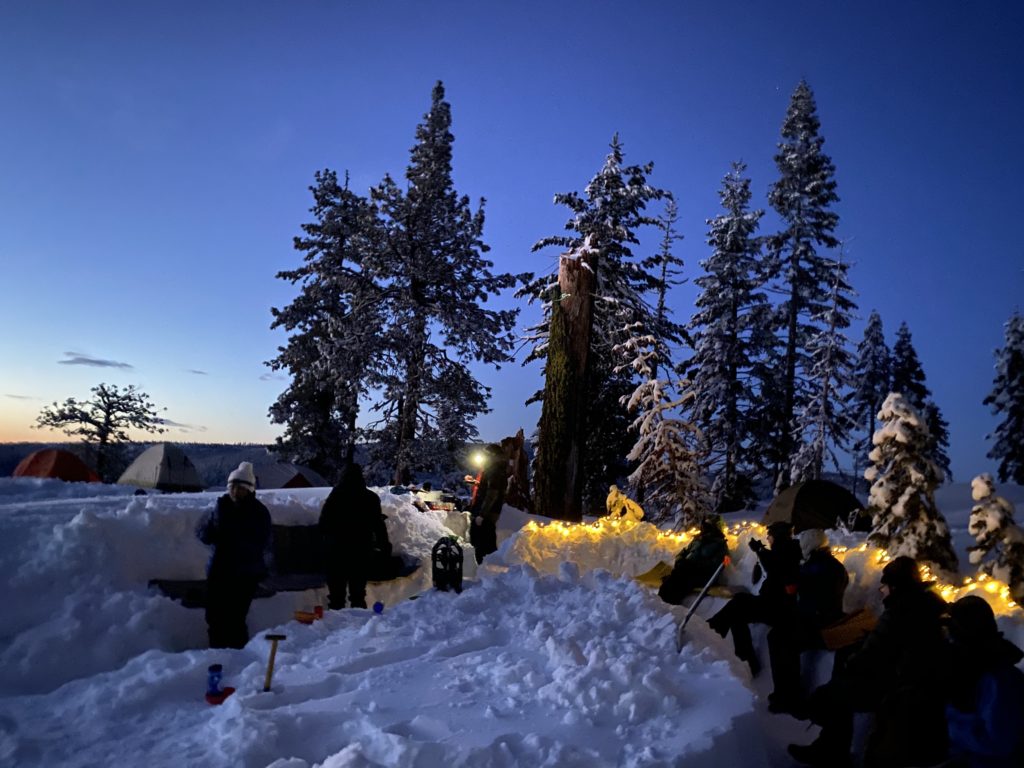
Creating an air shield
One of my surest ways to keep yourself warm when temperatures drop below average-flip-flop-weather is to wear clothing that creates little pockets of air on top of your skin. When the body gets cold, it starts producing more heat in order to keep your body warm enough to survive. Unfortunately, we do not have a great natural way to capture this heat, so we wear clothing to help trap it. This is why insulated (synthetic or down) jackets are so warm.
Insulated jackets use internal material that is extremely light and full of air pockets. Down or specific bird feathers are the lightest and warmest of the two options, but do not stay warm once wet. If the clothing is wind proof, or doesn’t allow air to penetrate the fabric, the clothing becomes that much better at keeping you warm.
A fleece jacket has lots of little pockets of air, but it’s normally unable to protect you from the wind. Adding a soft shell or rain jacket on top of a fleece jacket increases the warm rating dramatically. Add a windproof down jacket on top of that fleece and the warmth rating increases exponentially.
Ultimately layering will increase your warmth level and make it easier to quickly cool down if it starts getting too hot like hiking up hill in the snow or dancing in the sun at a bluegrass festival.
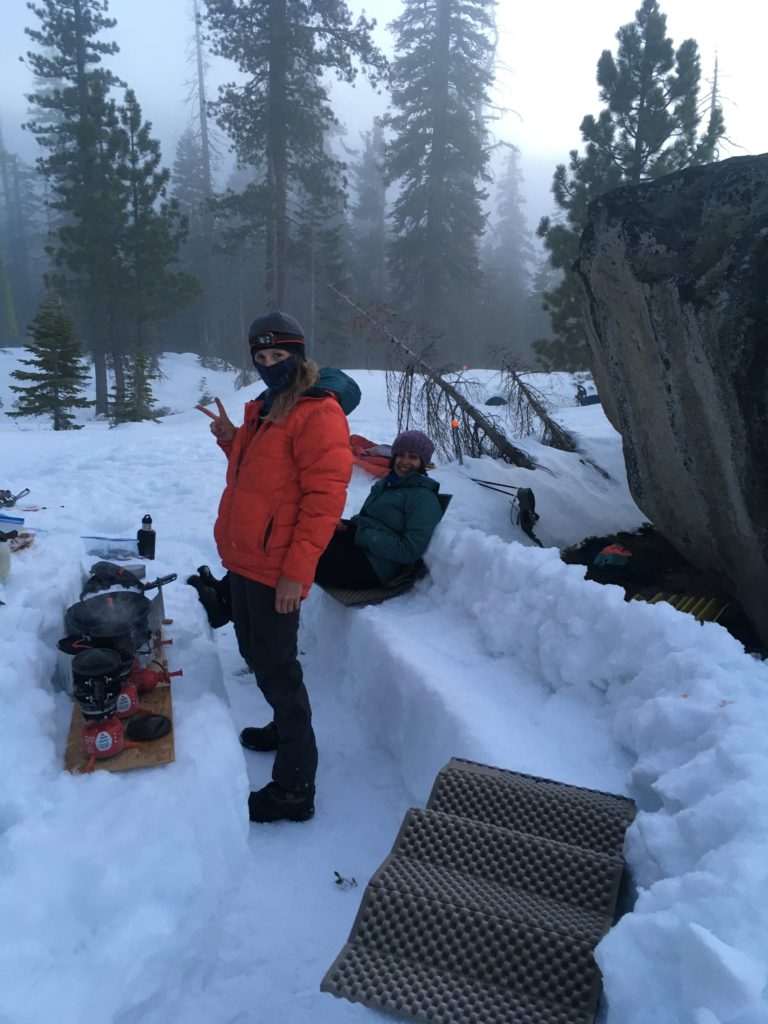
Keeping feet warm
I generally have bad circulation and find my toes and feet can get painfully cold. This can happen for a couple reasons.
One, if I wear boots or socks that are too tight and prevent circulation which prevents warm blood from reaching my toes. To avoid this I do not double up on socks in my boots or I’ll wear thinner socks in order to allow room for my feet to expand and my toes to move around. Having more space in your boots will allow warm air pockets to develop. If you prefer to wear a thicker sock, try to go for a larger boot size for the winter time.
Second, my feet get wet. Sometimes this is inevitable either because sweaty feet or snow gets into the tops of my boots. Either way, I carry extra socks to change into when we each camp in order to dry out my feet.
- Chemical hand warmers – These are pretty common and found in almost every outdoor store or online. They generate heat when you open the pouch and expose it to air. You should make sure to shake the pouch for a good minute before placing the pouch in your desired location. When my feet get really cold I like to stick one activated pouch into the top of my socks. This method really works well to keep my feet warm during the night and help me fall asleep fast.
- I usually wear a thin sock to bed. Sometimes I wake up and my feet are still cold. At this point I take my socks off and rub them together until they are warm. Each foot helps warm the other and will stay warmer longer.
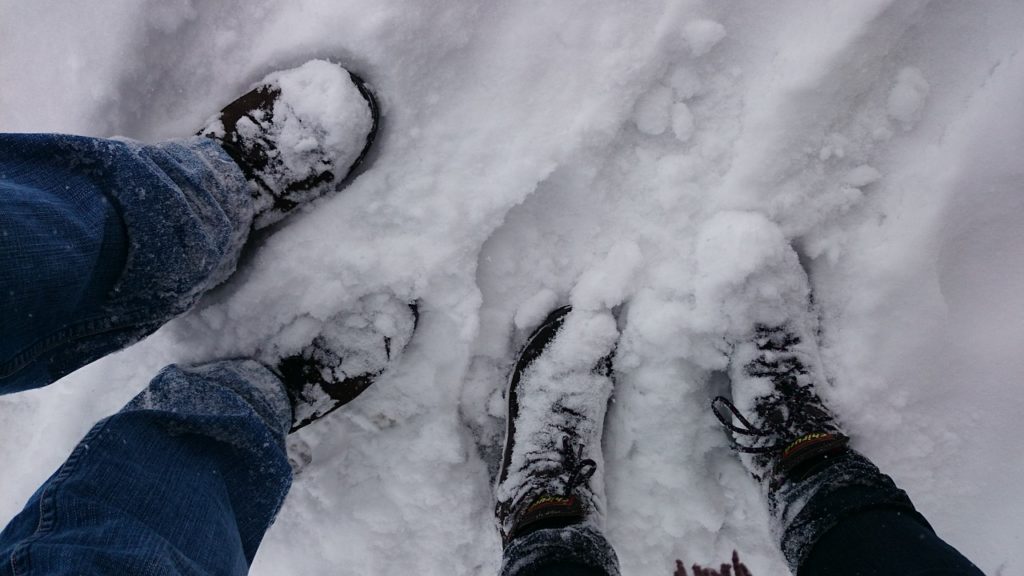
Staying dry or drying faster
Dry skin = warm skin. Ever notice that chill you can get after a long run? That layer of sweat, or water, on your skin and clothing increases the transfer of heat away from your body into the atmosphere. Wet skin is a much better conductor of heat than dry skin. This is why our bodies sweat when we do heavy exercise. Our skin produces sweat in order to keep our bodies at an optimal temperature. Our clothing soaks up that moisture and can take a long time to dry depending on the type of material.
Polyester or synthetic clothing usually dries at the quickest rate and can be extremely lightweight. Wool or merino wool is a natural material that comes from a variety of animals and can be very warm and quick to dry, but some find it scratchy and uncomfortable.
Cotton clothing is also natural plant material, but takes an extremely long time to dry.
Don’t know which is which in your wardrobe? Look for a small tag on the inside of your clothing, usually along a seam and towards the bottom, here the manufacturer will list material types in percentages.
To reduce the amount of time your clothes stay wet we always require clients to wear polyester or wool clothing. Cotton kills, as the saying goes. When you do get sweaty or wet from precipitation, change into dry clothing as soon as you arrive at camp. This will allow the first set of clothes to dry overnight. I like to put my wet socks at the bottom of my sleeping bag to help them dry and not freeze overnight. This also goes for my boots. I will place my boots in a waterproof bag and put them inside my sleeping bag, so they aren’t blocks of ice when I go to put them on the next morning.
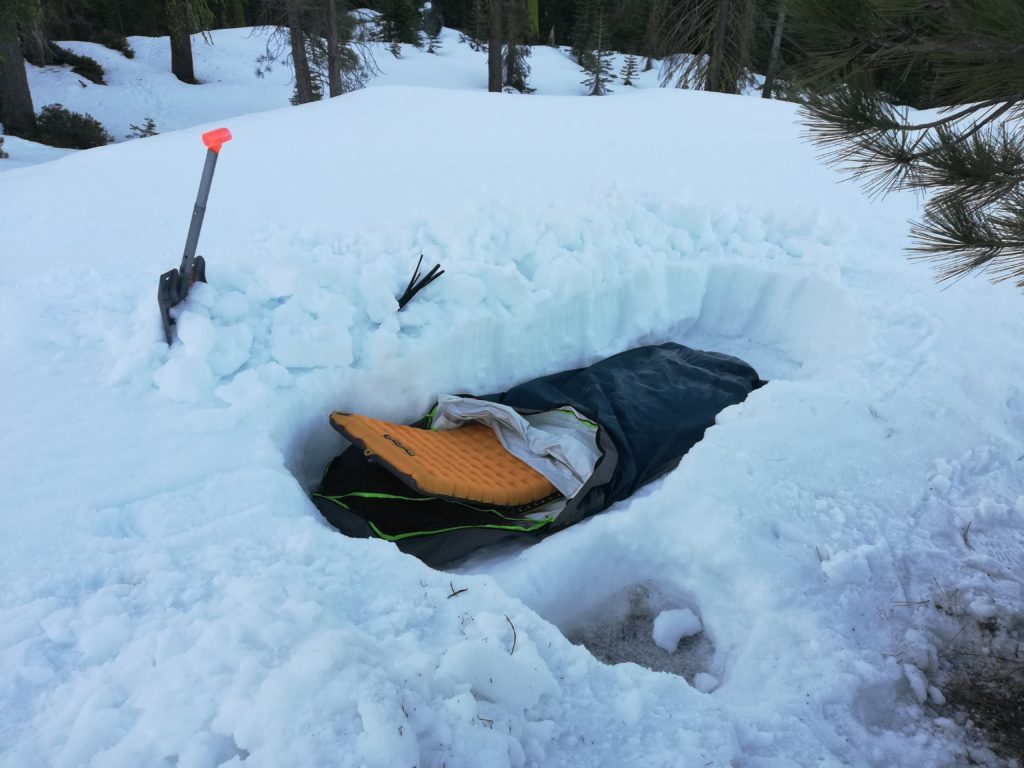
Constant eating
Eating lots of small meals/snacks is one way to keep you warm from the inside. You can wear the best down jacket in the world, yet if you don’t feed your body it will not have enough energy to heat up that cozy jacket. You want to eat a combination of food every couple hours, but in small quantities. This means a handful of trail mix full of dried fruit, nuts, chocolate, power bars, cookies, energy chews, fresh fruit (banana, grapes, or an apple), peanut butter, or cheese. I always have a cliff bar or bag of raisins in my pocket to snack on while walking. You want to choose food that is high in calories, but dense and portable. At night, I personally love stashing a pack of energy gummies or power bar in my sleeping bag close to my body so when I wake up and feel a tiny bit cold I’ll take a small bite.
A very full stomach will leave you lethargic and your arms and legs will feel colder because your body had to direct more blood to your stomach to digest that large meal, but don’t forgo a heavy meal around dinner time. Chances are you are burning more calories than average and need plenty to refuel for rest and repair.

Drinking water
Water is what helps us survive. If you are dehydrated, your body is working extra hard to keep vital functions working. This stresses your system and makes it harder to keep you feeling warm and comfortable.
Also…do not hold your pee! Your body is having to expend more vital energy to keep that full bladder (think of a water balloon) warm. Using the bathroom in the snow can be such an annoying feat of acrobatics trying to undo the right number of clothing layers, but it’s vital for your long term comfort and a way to avoid the emergency bathroom run. Advice? Take a squat right before bed even if you feel you don’t need to. I can almost guarantee you’ll go pee at least a little bit, which might prevent that 2 am bathroom run. There is no worse feeling than waking up super warm and cozy and knowing you will have to unzip your glorious sleeping bag and let out all that wonderful heat.
I find being hydrated also helps me sleep. A cold night tends to cause me to wake up more frequently but if i’ve been drinking enough water all day
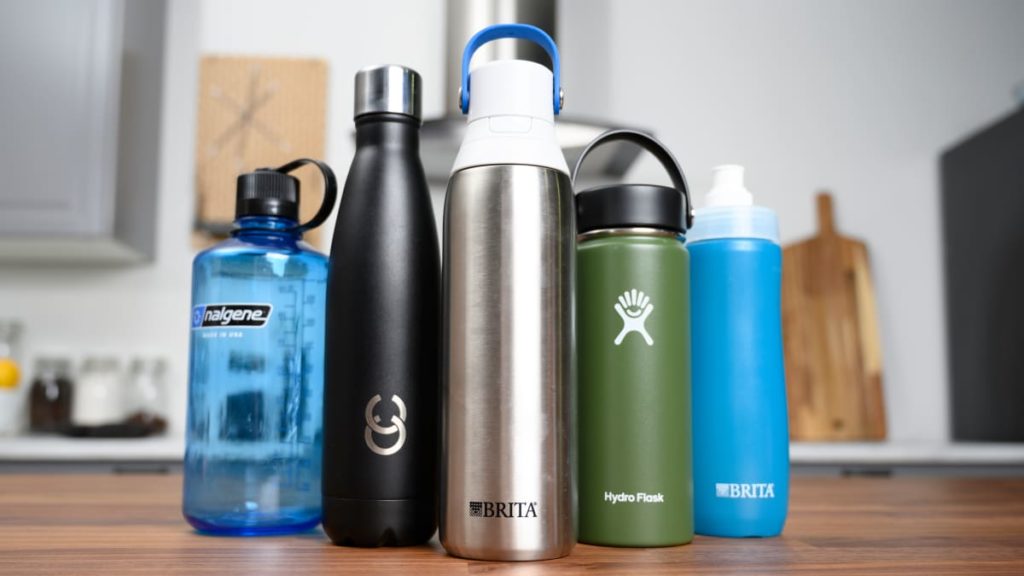
Moving and exercise
Keeping your body moving is a sure way to get warm and stay warm. Fast, repeated movements, but not sweaty exercise, can increase your heart rate and move warm blood to your extremities which will make them feel warmer more quickly. I alway do a couple sets of 10 jumping jacks or jump squats to get the warm blood flowing to your hands and feet. Doing a couple sets of these right before bed will make getting comfortable and falling asleep much easier.
Plastics over metal
Use cups and utensils that are free of metal or at least wear a glove when handling these items. Metal is an excellent conductor of heat and will draw warmth away from your body more quickly than plastics.
Tech and modern equipment
Modern day technology has allowed us to have jackets, socks and gloves with battery powered heat generators. Unfortunately, batteries are known to have a reduced time limit in cold temperatures. Carrying around a bunch of extra batteries can be heavy, but if you have tried everything above and still find yourself extremely cold then technology might be your answer.
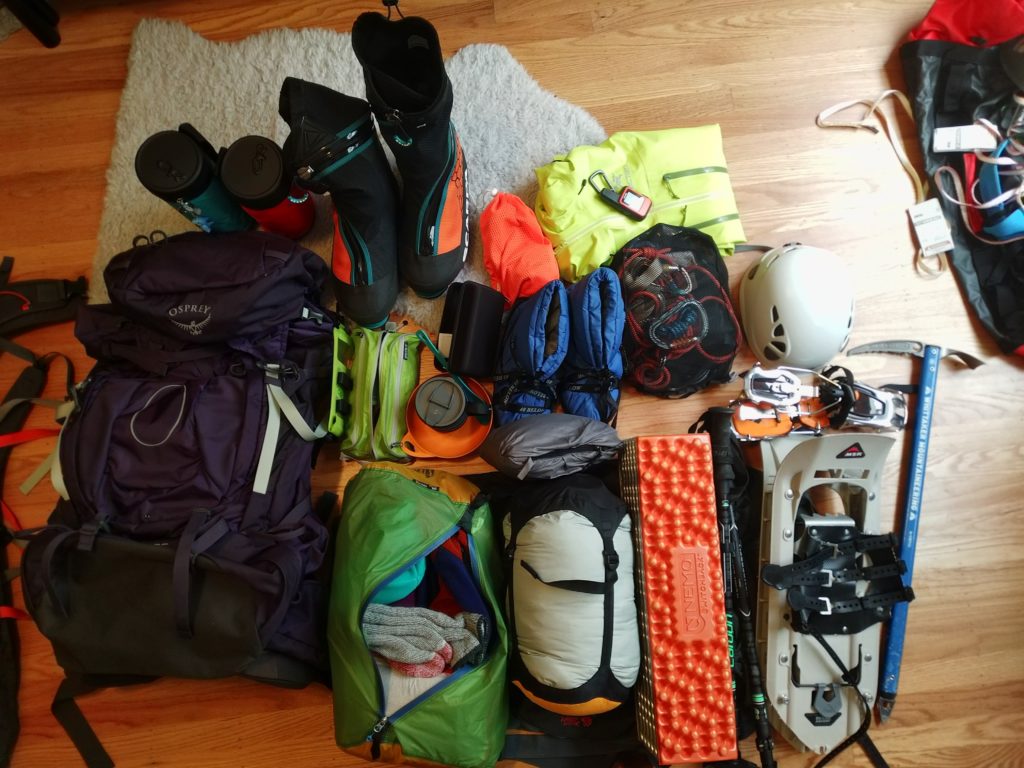
Keeping your body moving is a sure way to get warm and stay warm. Fast, repeated movements, but not sweaty exercise, can increase your heart rate and move warm blood to your extremities which will make them feel warmer more quickly. I alway do a couple sets of 10 jumping jacks or jump squats to get the warm blood flowing to your hands and feet. Doing a couple sets of these right before bed will make getting comfortable and falling asleep much easier.
What not to do
- Drink alcohol
- Wear cotton clothing
- Underestimate your sleeping bag
- Hold your pee
- Hike in too many layers, making yourself sweat and therefore making yourself cold
- Forget your extra socks
- Neglect to eat enough calories